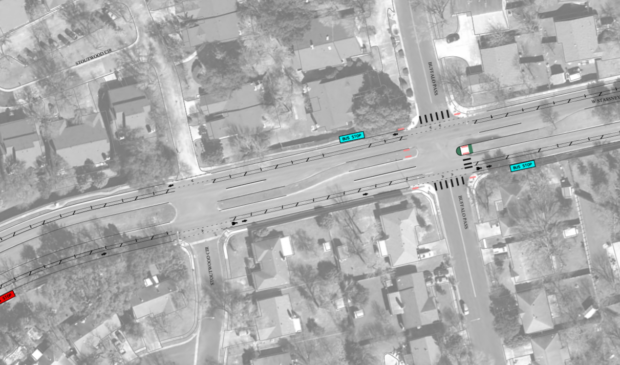Newsletter Signup
The Austin Monitor thanks its sponsors. Become one.
Most Popular Stories
- Cap Metro to shelve 46 new electric buses for a year after manufacturer bankruptcy
- Mobility Committee hears public concern regarding expansion of MoPac
- Red River music proponents see city funding as sign of support, progress
- Ethics complaint against Watson campaign still unsettled after hearing
- Austin Energy proposes gas peaker units, not larger combined cycle plant
-
Discover News By District

Advisory council urges city not to give up on safety at intersections
Tuesday, January 28, 2020 by Ryan Thornton
The Austin Transportation Department is combining 2016 mobility bond dollars with other funding sources to build out a citywide bike network, while the city’s Bicycle Advisory Council wants the department to rethink its approach to bicycle safety at intersections.
Last week, the advocacy board passed a recommendation asking street design engineers to consult intersection safety guidelines from the National Association of City Transportation Officials for the proposed multimodal improvements to Stassney Lane.
The Stassney Lane project includes conversion of two travel lanes into protected bike lanes between West Gate Boulevard and Menchaca Road; adding plastic flex posts as a protective bike lane barrier between Menchaca Road and South Congress Avenue; and a handful of improvements to bus stop design, pedestrian crossings and traffic signals.
While strongly supporting these improvements, several advisory council members noted that the project’s safety benefits are significantly reduced at intersections, where cyclists are asked at multiple points to cross in general traffic lanes or in a shared pedestrian/bike crossing.
The ideal scenario, said BAC Member Kathryn Flowers, is for all road users to be separated in dedicated pathways for the length of the entire project, including at intersections.
According to the NACTO guide, “Don’t Give Up at the Intersection,” poor design standards are responsible for most bike-vehicle crashes at intersections. The guide details a variety of ways to protect cyclists at intersections by slowing vehicle turn speed, making cyclists more visible and providing dedicated bike crossings and signals.
BAC Member Michelle LeBlanc – having cycled through these intersections along Stassney Lane – said the way cyclists are forced to navigate the intersection alongside turning car traffic is both unsafe and unnecessary. On top of the unsafe design, she said the corridor lacks signage reminding right-turning drivers to look for and yield to cyclists in the bike lane.
Nathan Wilkes of the department’s active transportation and street design division said improving these intersections with NACTO’s recommended signage and physical protections would require more resources than the division has available.
With the goal of connecting a citywide network, Wilkes said the division looks for projects that can be improved with a relatively small investment.
For example, he said, the reason the Stassney Lane project ends at South Congress Avenue instead of connecting to the bikeway proposed for South Pleasant Valley Road is that it would cost too much to make that segment of Stassney safe for cyclists.
Even so, the Bicycle Advisory Council’s recommendation asks the department to extend the project beyond South Congress Avenue, where the road gets wider and traffic gets faster as it approaches Interstate 35, all the way to South Pleasant Valley Road.
The project’s protected one-way bike lanes are kept to the right of street traffic, making dedicated right-turn lanes for vehicles a particular threat to safety.
In designing the project, the department did not remove or make changes to existing “slip lanes,” dedicated right-turn lanes where right-turning vehicles are required to cross over the bike lane to ease into a graded turn.
At heavy right turns such as these, Wilkes said the department would need to add bike signals and change street geometry in order to keep bike lanes to the right of turn lanes, an effort that would require more funding than the project has available.
The NACTO guide says cities should consider installing bike signals that give cyclists a head start at intersections whenever a bike lane is next to a dedicated turn lane. However, due to the interaction between bike signals and general traffic signals, Wilkes said the division has little power to make those kinds of changes.
“That’s a complex topic where our hands are generally pretty tied,” he said. “The short of it is, we need a lot better national tools for bicycle signalization.”
The project’s public comment period closed Jan. 19, but Wilkes said it wasn’t too late for the division to consider the recommendation. The recommendation passed on consensus.
Project map courtesy of the city of Austin.
The Austin Monitor’s work is made possible by donations from the community. Though our reporting covers donors from time to time, we are careful to keep business and editorial efforts separate while maintaining transparency. A complete list of donors is available here, and our code of ethics is explained here.
You're a community leader
And we’re honored you look to us for serious, in-depth news. You know a strong community needs local and dedicated watchdog reporting. We’re here for you and that won’t change. Now will you take the powerful next step and support our nonprofit news organization?









